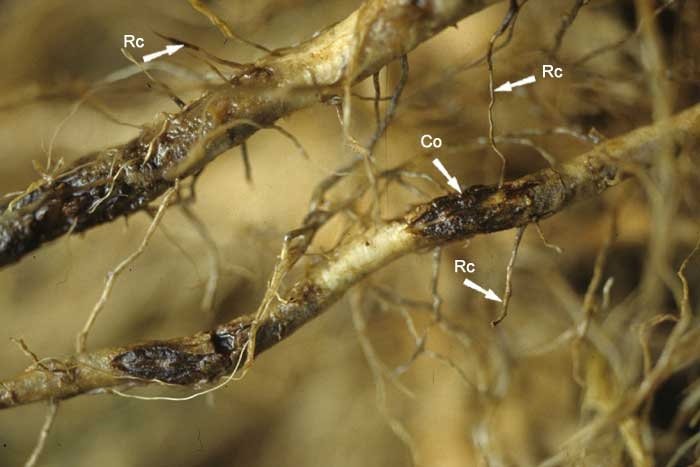
Root and collar abnormalities and lesions
Three types of symptoms will be studied in the section Root and collar abnormalities and lesions:
- root and/or collar yellowing or browning (blackening, suberisation);
- various abnormalities of roots (cysts, galls ...);
- various lesions of the collar and the portion of the stem near the soil level
There can be several causes for such symptoms. Most of the times the causes are parasitic and quite different kind of pests may be involved:
- bacteria, such as Agrobacterium tumefaciens, Pectobacterium sp. Ralstonia solanacearum;
- many fungi, such as Botrytis cinerea, Calonectria crotalariae (syn. Cylindrocladium crotalariae) Diaporthe ziziphina, Fusarium oxysporum f. nicotianae, Haematonectria haematococca (former Fusarium solani), Helicobasidium monpa, Macrophomina phaseolina, Phytophthora nicotianae, Pythium spp. (figure 1), Rhizoctonia solani, Sclerotinia sclerotiorum, Athelia rolfsii (former Sclerotium rolfsii), Thielaviopsis basicola (syn. Chalara elegans, figures 2 and 3) and Verticillium dahliae;
- other pests, including nematodes, such as Globodera tabacum, Meloidogyne spp. Pratylenchus spp. Ditylenchus dipsaci, or parasitic plants such as orobanche.
- note that other pests can also be involved (wireworms, cutworms ...).
Non-parasitic causes may also provoke these symptoms: e.g. root asphyxia (waterlogging), hardpan...
 |
 |
 |
| Figure 1 | Figure 2 | Figure 3 |
We have deliberately grouped the root, collar and lower stem lesions in the same section for at least two reasons:
- First, these three parts of the plant cannot be separated. Indeed, the fungi attacking the roots are sometimes able to colonise the collar and the lower stem and vice versa, and the fungi which are rather subservient to the collar occasionally extend to the roots;
- Moreover, the diagnosis of diseases affecting these three organs is particularly difficult because they usually cause very similar symptoms. It is very easy to get confused and it is not possible to have as simple and structured diagnostic approach as in other fields.
We recommend you to observe thoroughly, and carefully follow the advice given throughout this section.
- A difficult diagnosis
The root system, in tobacco, as in many other species, is the least visible part and therefore the most difficult to observe. Many growers and technicians do not know how to evaluate roots, because often they are not in good conditions to do so.
In order to assess the health of this plant part, one should be placed in good observation conditions.
 |
 |
| Figure 1 | Figure 2 |
First, the root system(s) must be carefully collected, avoiding to pull it (them) out abruptly because the affected parts are the most vulnerable and they tend to stay more easily in the soil; however roots are also the most interesting for diagnosis purposes. Then, it is essential to wash them carefully with water and clean them of soil particles that often mask certain symptoms.
Once cleaned you may examine the roots. Do it carefully and use a hand lens if you have one.
If the collar and the lower stem are affected (figures 1 and 2) then observe also the root system and see the section of Stem lesions.





